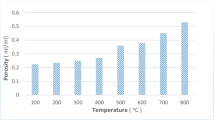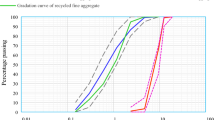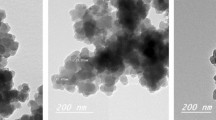Abstract
Currently, nanoparticles are used as admixtures to reduce the thermal deterioration of concrete after exposure to fire. However, the influence of high temperature on high-strength concrete (HSC) containing silica fume and nanoparticles has not been investigated well. In this study, various HSC mixes incorporated with 1%, 2%, 3% and 4% nanosilica (NS) or 1% and 2% nanoferrite (NF) were prepared to produce HSC with high enduring strength after being subjected to high temperatures of up to 800 °C and actual fires. The specimens were assessed via scanning electron microscopy, compression and splitting tensile tests, modulus of elasticity test, and water permeability coefficient analysis. Results showed that using NS and NF percentages of up to 3% and 2%, respectively, in HSC improved the mechanical properties and water permeability coefficient at elevated temperatures. The compressive strength of the heated specimens with 3% NS was better than those with 2% NF at temperatures 200 °C–800 °C. With regard to the microstructure feature, the results confirmed that NS acted as an adequate filling material, which produced a condensed microstructure with extra compressed hydration outputs. This may be associated to higher pozzolanic reaction of NS with high distribution that formed additional calcium silicate hydrate gel. The specimens with 3% NS had no cracks until the temperature of 800 °C, but their porosity increased slightly.
















Similar content being viewed by others
Data availability
Data can be provided by demand from the corresponding author.
References
Tawfik TA, Metwally KA, El-Beshlawy S, Al Saffar DM, Hassan HS. Exploitation of the nanowaste ceramic incorporated with nano silica to improve concrete properties. J King Saud Univers Eng Sci. 2021;33(8):581–8.
Zeyad AM, Johari MAM, Alharbi YR, Abadel AA, Amran YM, Abutaleb A. Influence of steam curing regimes on the properties of ultrafine pofa-based high-strength green concrete. J Build Eng. 2021;38:102204.
Zeyad AM, Johari MAM, Abutaleb A. The effect of steam curing regimes on the chloride resistance and pore size of high–strength green concrete. Constr Build Mater. 2021;280:122409.
Hamada H, Yahaya F, Muthusamy K, Al-Attar A. Effects of nano-palm oil fuel ash and nano-eggshell powder on concrete. Construct Build Mater. 2020;261:119790.
Alaloul WS, Musarat MA, Sivalingam S, Rosli MFB, Haruna S, Khan MI. Mechanical and deformation properties of rubberized engineered cementitious composite (ecc). Case Stud Constr Mater. 2020;13:e00385.
Amin M, Zeyad AM, Agwa IS. Effects of nano cotton stalk and palm leaf ashes on ultrahigh-performance concrete properties incorporating recycled concrete aggregates. Construct Build Mater. 2021;302:124196.
Shahidan S, Tayeh BA, Jamaludin AA, Bahari NA, Mohd SS, Ali NZ, Khalid FS. Physical and mechanical properties of self-compacting concrete containing superplasticizer and metakaolin. InIOP Conference Series: Materials Science and Engineering 2017 (Vol. 271, No. 1, p. 012004). IOP Publishing
Amin M, Agwa IS. Effect of using mineral admixtures and ceramic wastes as coarse aggregates on properties of ultrahigh-performance concrete. J Clean Prod. 2020;273:123073.
Tobbala DE. Effect of nano-ferrite addition on mechanical properties and gamma ray attenuation coefficient of steel fiber reinforced heavy weight concrete. Constr Build Mater. 2019;207:48–58.
Janković K, Bojović D, Stojanović M. Influence of nanoparticles on the strength of ultra-high performance concrete. In: Nanotechnology in eco-efficient construction Pacheco-Torgal F, Diamanti MV, Nazari A, Granqvist CG, Pruna A, Amirkhanian S (Editors), 2019 (pp. 13-42). Woodhead Publishing
Sumesh M, Alengaram UJ, Jumaat MZ, Mo KH, Alnahhal MF. Incorporation of nano-materials in cement composite and geopolymer based paste and mortar - a review. Constr Build Mater. 2017;148:62–84.
Li H, Xiao H-G, Yuan J, Ou J. Microstructure of cement mortar with nano-particles. Compos B Eng. 2004;35(2):185–9.
Li H, Zhang M-H, Ou J-P. Abrasion resistance of concrete containing nano-particles for pavement. Wear. 2006;260(11–12):1262–6.
Schoepfer J, Maji A. An investigation into the effect of silicon dioxide particle size on the strength of concrete. Am Concr inst ACI Special Publication. 2009;267:45–58.
Faried AS, Mostafa SA, Tawfik TA. The effect of using nano rice husk ash of different burning degrees on ultra-high-performance concrete properties. Constr Build Mater. 2021;290:123279.
Mechanical and durability properties of ultra-high performance concrete incorporated with various nano waste materials under different curing conditions. J Build Eng 2021;43:102569.
Tayeh BA, Hasaniyah MW, Zeyad AM, Awad MM, Alaskar A, Mohamed AM, Alyousef R. Durability and mechanical properties of seashell partially-replaced cement. J Build Eng. 2020;31:101328.
Kumar R, Singh S, Singh LP. Studies on enhanced thermally stable high strength concrete incorporating silica nanoparticles. Constr Build Mater. 2017;153:506–13.
Amin M, Gamal SMA, Hashem F. Effect of addition of nano-magnetite on the hydration characteristics of hardened Portland cement and high slag cement pastes. J Therm Anal Calor. 2012;112:1253–9.
Amin M, Tayeh BA. Investigating the mechanical and microstructure properties of fibre-reinforced lightweight concrete under elevated temperatures. Case Stud Constr Mater. 2020;13: e00459.
Elsayed M, Abou Elmaaty M, Aldahshoory Y. Behaviour of rc columns strengthened with ultra-high performance fiber reinforced concrete (uhpfrc) under eccentric loading. J Build Eng. 2022;47:103857.
Amin M, Zeyad AM, Tayeh BA, Agwa IS. Effect of ferrosilicon and silica fume on mechanical, durability, and microstructure characteristics of ultra high-performance concrete. Constr Build Mater. 2022;320:126233.
Tobbala DE, Abdelsalam BA, Agwa IS. Bond performance of a hybrid coating zinc-rich epoxy incorporating nano-ferrite for steel rebars subjected to high temperatures in concrete. J Build Eng. 2020;32:101698.
Bastami M, Baghbadrani M, Aslani F. Performance of nano-silica modified high strength concrete at elevated temperatures. Constr Build Mater. 2014;68:402–8.
Abdul-Rahman M, Al-Attar AA, Hamada HM, Tayeh B. Microstructure and structural analysis of polypropylene fibre reinforced reactive powder concrete beams exposed to elevated temperature. J Build Eng. 2020;29:101167.
Al-Attar AA, Abdulrahman MB, Hamada HM, Tayeh BA. Investigating the behaviour of hybrid fibre-reinforced reactive powder concrete beams after exposure to elevated temperatures. J Mater Res Technol. 2020;9:1966–77.
Yonggui W, Shuaipeng L, Hughes P, Yuhui F. Mechanical properties and microstructure of basalt fibre and nano-silica reinforced recycled concrete after exposure to elevated temperatures. Constr Build Mater. 2020;247:118561.
Al Saffar DM, Tawfik TA, Tayeh BA. Stability of glassy concrete under elevated temperatures. Eur J Environm Civil Eng. 2021;26:1–12.
Haido JH, Tayeh BA, Majeed SS, Karpuzcu M. Effect of high temperature on the mechanical properties of basalt fibre self-compacting concrete as an overlay material. Constr Build Mater. 2021;268:121725.
Tayeh BA, Zeyad AM, Agwa IS, Amin M. Effect of elevated temperatures on mechanical properties of lightweight geopolymer concrete. Case Stud Constr Mater. 2021;15: e00673.
Abed MA, Tayeh BA, Abu Bakar B, Nemes R. Two-year non-destructive evaluation of eco-efficient concrete at ambient temperature and after freeze-thaw cycles. Sustainability. 2021;13:10605.
Ramadan M, Amin M, Sayed MA. Superior physico-mechanical, fire resistivity, morphological characteristics and gamma radiation shielding of hardened opc pastes incorporating znfe2o4 spinel nanoparticles. Constr Build Mater. 2020;234:117807.
Ibrahim RK, Hamid R, Taha MR. Fire resistance of high-volume fly ash mortars with nanosilica addition. Constr Build Mater. 2012;36:779–86.
Ramadan M, Amin MS, Sayed MA. Superior physico-mechanical, fire resistivity, morphological characteristics and gamma radiation shielding of hardened opc pastes incorporating znfe2o4 spinel nanoparticles. Constr Build Mater. 2020;234:117807.
El-Enein SAA, Kishar EA, Zedan SR, Mohamed RA. Effect of nano-sio2 (ns) on dolomite concrete towards alkali silica reaction. HBRC J. 2018;14(2):165–70.
Nili M, Ehsani A. Investigating the effect of the cement paste and transition zone on strength development of concrete containing nanosilica and silica fume. Mater Des. 2015;75:174–83.
Ahmed MA, Ahmed SA, Metwally ME, Sherif MA, Tobbala DE Preparation of nano-silica from rice husk ash using acid chemical treatment and burning. The International Conference of Engineering Sciences and Applications, Aswan, Egypt, 2016
ASTM, C143/ and C143M-15a, "Standard test method for slump of hydraulic-cement concrete," ASTM International, West Conshohocken, PA 2015.
ASTM, C33 and C33M-18, "Standard specification for concrete aggregates," ASTM International, West Conshohocken, PA, 2018.
ASTM, Standard test methods for fire tests of building construction and materials, ASTM International, West Conshohocken, PA., 2000.
Abhilash PP, Nayak DK, Sangoju B, Kumar R, Kumar V. Effect of nano-silica in concrete; a review. Constr Build Mater. 2021;278:122347.
Heikal M, El-Didamony H, Sokkary TM, Ahmed IA. Behavior of composite cement pastes containing microsilica and fly ash at elevated temperature. Constr Build Mater. 2013;38:1180–90.
Lubloy E, Balazs GL, Czoboly O, Harman B Influence of silica fume on fire resistance. 2011:305–308.
Abhilash PP, Nayak DK, Sangoju B, Kumar R, Kumar V. Effect of nano-silica in concrete; a review. Constr Build Mater. 2021;278:122347.
Funding
No funding was provided during this research.
Author information
Authors and Affiliations
Corresponding author
Ethics declarations
Conflict of interest
All authors claim that they have no conflict of interest.
Additional information
Publisher's Note
Springer Nature remains neutral with regard to jurisdictional claims in published maps and institutional affiliations.
Rights and permissions
About this article
Cite this article
Tobbala, D.E., Rashed, A.S., Tayeh, B.A. et al. Performance and microstructure analysis of high-strength concrete incorporated with nanoparticles subjected to high temperatures and actual fires. Archiv.Civ.Mech.Eng 22, 85 (2022). https://doi.org/10.1007/s43452-022-00397-6
Received:
Revised:
Accepted:
Published:
DOI: https://doi.org/10.1007/s43452-022-00397-6




